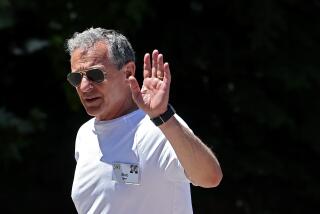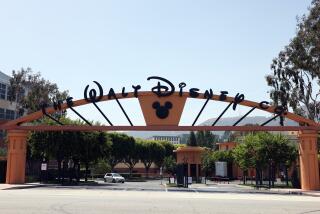The Heir to Akers : IBM Reportedly Focusing on Outsiders in Search for a CEO
- Share via
NEW YORK — One month into the search for a chief executive capable of transforming International Business Machines, a seven-member team of directors has decided to focus exclusively on candidates from outside the company, sources close to IBM say.
Initially, the committee--led by former Johnson & Johnson Chief Executive James E. Burke--favored hiring either someone from inside the besieged computer firm or a former IBM executive, these sources say.
But directors quickly realized that anxious shareholders--whose company has lost more than $70 billion in market value since IBM stock hit a high of $175 a share in August, 1987--might misinterpret such a choice.
The board, it seems, did not want to appear anything less than acutely aware of just how drastically future management must differ from the past.
The markets’ message has been telegraphed by both institutional and small investors.
A deluge of complaints to the company’s Armonk, N.Y., headquarters reached a crescendo late last year, after IBM announced that its dividend would be cut by more than half and its 1992 loss would total $4.97 billion. The outcry played a critical role in prompting current CEO John Akers to announce that he would step aside.
Said the chief investment officer of a large state pension fund: “It would certainly be our preference to have the committee select an outsider, though we are not pressing our views on directors.”
Then again, he doesn’t need to, noted the investment officer, who asked not to be identified. “Wall Street money managers have lobbied vociferously on that point,” he said.
IBM’s board might well have preferred to promote an insider--or, maybe, someone “mildly inside,” such as former IBM executive Michael Armstrong, now the chairman of Hughes Aircraft, according to William S. Anderson, former chairman of NCR Corp.
“But the message they must send to analysts, investors and employees is that they are ready, willing and able to be a drastically different company,” said Anderson, who himself transformed NCR from a sleepy manufacturer of mechanical cash registers into an effective competitor of IBM before his retirement eight years ago. “The only way they can do that is to have a CEO who has never been with IBM.”
IBM’s board is loaded with business luminaries: Thomas S. Murphy, chairman of Capital Cities/ABC; Thomas F. Frist Jr., chairman of Hospital Corp. of America; J. Richard Munro, retired chairman of Time Warner.
Yet many consultants and former IBM executives say it is obvious that the board was too slow to realize how deep--even intractable--IBM’s problems are.
Concern arises, in part, from the fact that the board supported Akers’ policies until Jan. 26, the day he submitted his resignation, which is effective when a replacement is found. By then a chorus of critics--including Business Week, the Economist and Fortune--had called for Akers’ departure.
“No one told these seven board members (on the search committee) when they were appointed that they would have to know something about IBM,” said the influential consultant Bob Djurdjevic, president of Phoenix-based Annex Research. “Now, not only do they have to make decisions, they have to make them in the spotlight.”
Djurdjevic holds the board partially responsible for IBM’s slowness to recognize the urgency of its problems. One of the first steps the new CEO should take, he said, is to “purge the slow-to-adapt old-timers from the IBM board.”
The board in effect has maintained a blackout on details of its search, in sharp contrast to the messy leaks that accompanied American Express directors’ ultimately successful efforts to oust former CEO James Robinson III at the end of January.
Last week, the Wall Street Journal reported that the IBM committee is considering about six finalists, including Morton Meyerson, chairman of Perot Systems; George Fisher, chief executive of Motorola, and Louis Gerstner, chairman of RJR Nabisco. But the Journal warned that “it wasn’t certain” that those three men were official finalists.
The Journal also reported that a new CEO was likely to be chosen by the end of March, one month ahead of the three-month deadline the committee has imposed on its search.
IBM spokesman Rob Wilson said the company had no comment on the names of potential candidates or the timing of an appointment. Representatives of Motorola and RJR Nabisco said their companies also had no comment.
DeSoto Jordan, vice president of Perot Systems, said: “Mr. Meyerson has made it clear he expects to be leading Perot Systems for the foreseeable future.”
Two other candidates widely believed to be under consideration are John Sculley, chairman of Apple Computer, and Paul Stern, non-executive chairman of Northern Telecom.
Apple did not return a phone call requesting comment. Robert O’Brien, vice president of Northern Telecom, said Stern did not wish to discuss the report.
While IBM shareholders and employees are pinning their hopes for a resuscitated company on new direction from the top, consultants and former executives said they doubt that quick or painless fixes are on the horizon.
“Some who might be capable of doing the job of CEO won’t want it,” said former IBM executive Kenneth Bosomworth, president of International Resource Development in New Canaan, Conn. “The opinion of many of IBM’s competitors is that the company is in much worse shape than the board thinks.”
Bosomworth had been advising his clients for a decade that IBM was falling behind in technology and new products and losing too many talented executives. Today, he said, he believes that nobody will be able to turn around the $65-billion company.
IBM “is stuck with problems that are not resolvable,” Bosomworth said. Laughing, he added: “Of course, the board would disagree with everything I’ve said.”
Bosomworth has told clients that three to five more years of very severe problems lie ahead--woes that will cause losses of $5 to $10 per share in at least three of those years. He predicts that IBM stock, which closed at $54.37 a share on Friday, may eventually skid to as low as $15.
“That’s not a unique opinion,” Bosomworth said. “Lots of people in the industry are equally bearish.”
IBM’s board may be bracing to dispense some tough medicine. One policy under consideration, sources said, is cutting the salaries of all employees--from top executives to the lower ranks. “Like our President,” said one source, “they will ask everyone to share the pain.”
Evidence of one break with IBM’s lustrous past came Wednesday, when the firm announced the first layoffs in its 79-year history. IBM said it would eliminate 500 headquarters jobs next month. Worldwide, more than 25,000 more workers--no exact number has been disclosed, but some analysts predict that it may reach 70,000--will lose their jobs by the end of this year.
IBM already has cut 106,000 people from its payroll through attrition and voluntary programs.
Former employees who asked not to be quoted said that recent generous buyouts have exacerbated the company’s problems. In too many cases, they said, the more talented employees accepted buyouts, because they could get other jobs.
That, they said, has left the company with an inordinate number of “tree-huggers,” IBM’s term for people who will never leave and who contribute little.
Many, though by no means all, analysts suggest that IBM should be broken up into a number of smaller, independent companies. The task would be monumentally difficult, because IBM is integrated both vertically and horizontally. Profit and loss responsibility in the past was assigned solely to top corporate offices.
Morgan Stanley and Boston Consulting Group have been retained to help figure out how such a breakup could be structured. One impediment: a legal requirement that new companies that want to issue stock must provide two years of financial statements.
“When I left a year ago,” said one former IBM executive, “accounting systems were still inadequate to allow each unit to stand alone.”






